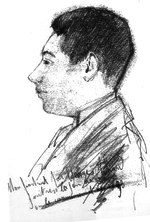art.wikisort.org - Artist
Pierre Albert-Birot (22 April 1876 – 25 July 1967) was a French avant-garde poet, dramatist, and theater manager.
This article may be expanded with text translated from the corresponding article in French. (October 2021) Click [show] for important translation instructions.
|
Pierre Albert-Birot | |
|---|---|
 Portrait by Georges Achard | |
| Born | 22 April 1876 Angoulême, France |
| Died | 25 July 1967 (aged 91) Paris, France |
| Nationality | French |
| Known for | poet, dramatist, theater manager |
| Movement | Modernism |
Early life
Born in Angoulême, Albert-Birot moved to Paris in 1894. There he attended art school and befriended Gustave Moreau. He worked for five decades as a restorer for antique dealer Madame Lelong. He began writing after he met the musician Germaine de Surville in 1913.
Before the First World War, he participated in the emerging modern art movement, as a painter, sculptor, poet, theater presenter, playwright and creator of groups and magazines. His friend Guillaume Apollinaire dubbed him Pyrogène ("Pyrogen"), because of his "fiery" temperament as an innovator and disruptor.
SIC
From January 1916 to December 1919, Albert-Birot edited the avant-garde art magazine SIC, an acronym for Sons Idées Couleurs ("Sounds Ideas Colors"), which featured writings by Futurists, Surrealists, and Dadaists. SIC became a focus for many avant-garde initiatives, even those which Albert-Birot himself disliked, he believing in independence and objectivity.[1]
Poetry
This list is incomplete; you can help by adding missing items. (October 2021) |
Albert-Birot wrote several books of poetry, including:
- Trente et un Poèmes de Poche ("Thirty-one Pocket Poems"), 1917
- Poèmes quotidiens, ("Everyday Poems"), 1919
- La Triloterie, 1920
- Poèmes à l'autre moi ("Poems to the Other Me"), 1927
- Amenpeine, 1938
- La Clé des Champs
- La Panthere noire ("The Black Panther"), 1938
- Les Amusements naturels ("Natural Amusements"), 1945
- Cent dix gouttes de poésie ("110 drops of poetry", 1952
His poetry is inseparable from his early theatrical work: lyric, funny and eminently modern.
Prose
His novel Grabinoulor appeared in 1919.[inconsistent] Bernard Jourdan definitively established that the name of the hero of this stream of consciousness, from which all punctuation is banned, is a near-anagram of "We Albert-Birot";[dubious ] Grabinoulour, a very modern man, has a host of adventures, some everyday, others fantastic, with nods to the heroes of Rabelais' and Lewis Caroll's works, but also, and above all, to the supermen of modern mythology, from Fantômas to Tarzan, from Arsène Lupin to science fiction heroes traveling through the space and time.
Pierre Albert-Birot was a very singular man, a fringe poet who fascinated later generations with fanciful novels such as the 1934 Rémy Floche, employé ("employee"). He also wrote literary translations of Homer, Eschylus and Virgil, translations of medieval poets into Modern French, and studies of prosody.
Theater
In 1917, Albert-Birot directed the first performance of Les mamelles de Tirésias by Guillaume Apollinaire, a friend who had also been a contributor to SIC. He went on to write numerous plays of his own, including Barbe-Bleue ("Bluebeard"); Les Femmes pliantes ("Flexible Women"); and L'homme coupé en morceaux ("The Dismembered Man").[2]
In 1929 he founded his own theater, Le Plateau. Being unable to afford to produce others' works, he produced his own series of short performance pieces entitled Pièces-Études ("Study pieces").[2]
References
- ars libri (2011). "Dada and Modernist Magazines". Dada-companion.com. DADA Companion. Archived from the original on 6 September 2015. Retrieved 27 December 2011.
- Forman, Edward (2010). Historical Dictionary of French Theater. Lanham, Maryland: Scarecrow Press. p. 22. ISBN 978-0-8108-4939-6. Retrieved 27 December 2011.
Further reading
- Kelly, Debra (1 December 1996). Pierre Albert-Birot: A Poetics in Movement, A Poetics of Movement. Madison, New Jersey: Fairleigh Dickinson University Press. ISBN 978-0838636251.
External links
- Covers and excerpts from all fifty-four issues of SIC, scanned and archived by the University of Iowa library
Jean Rousselot. Dictionnaire de la poesie francaise contemporaine 1968, Auge, Guillon, Hollier -Larousse, Mooreau et Cie.-Librairie Larousse, Paris
На других языках
[de] Pierre Albert-Birot
Pierre Albert-Birot (* 22. April 1876 in Angoulême; † 25. Juli 1967 in Paris) war ein französischer Lyriker und Autor, der dem Dadaismus nahestand.[1]- [en] Pierre Albert-Birot
[fr] Pierre Albert-Birot
Pierre Albert-Birot, né le 22 avril 1876 à Angoulême et mort le 25 juillet 1967 à Paris, est un poète, sculpteur, peintre, typographe et homme de théâtre français. Avant-gardiste invétéré pendant la Première Guerre mondiale, à travers la revue Sic (1916-1919) dont il est le fondateur et directeur, il s’est fait le défenseur du futurisme[2] et du cubisme[3]. Les dadaïstes le considéreront comme l’un des leurs, sans que lui-même y souscrive jamais[4]. Il se déclare fondateur de l’école « nunique » (de l’adverbe grec νῦν / nun, maintenant), école dont il est le seul maître, sans disciples. Se tenant après la guerre à l’écart des surréalistes auxquels il a pourtant, avec Guillaume Apollinaire, donné leur nom, il a construit une œuvre solipsiste et touche à tout, imprimant ses livres chez lui, cultivant la joie enfantine de la création artistique, ainsi qu’il l’écrit lui-même : « Je trouve ma joie dans la création poétique et je trouve ma joie dans les créations de mes mains. […] Tout cela, c’est du jeu, j’aime jouer, j’entretiens le gosse. »[5],[N 1]Другой контент может иметь иную лицензию. Перед использованием материалов сайта WikiSort.org внимательно изучите правила лицензирования конкретных элементов наполнения сайта.
WikiSort.org - проект по пересортировке и дополнению контента Википедии